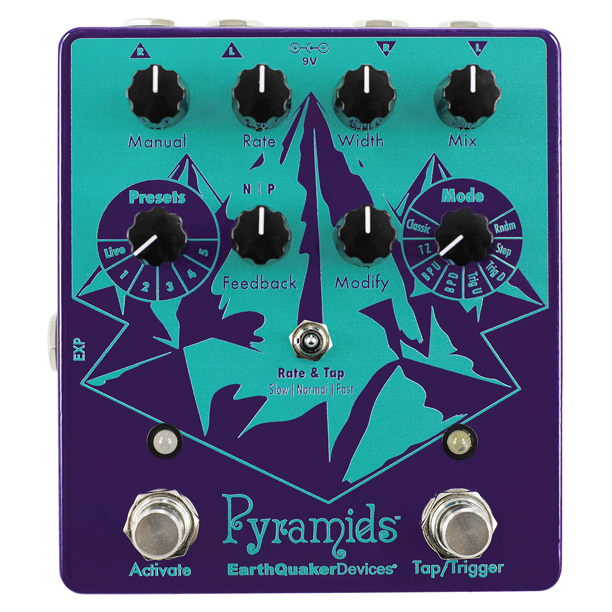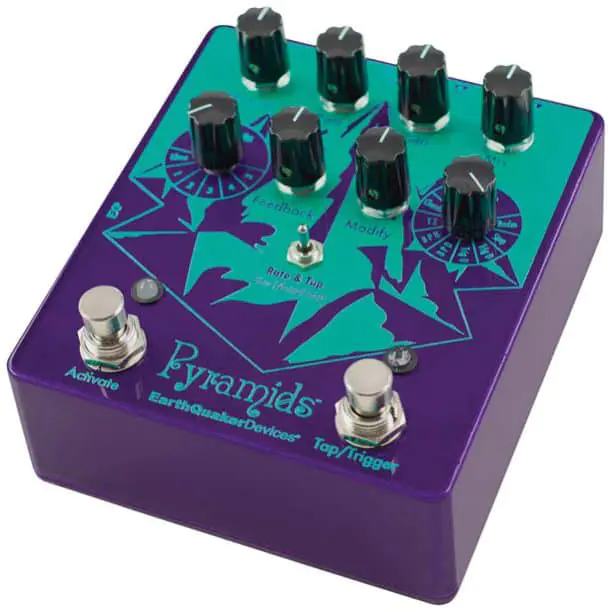
FYI We are currently having a giveaway for a EQD Pyramids linked to our Brooklyn Stompbox Exhibit (June 9-10)
When we think of flanging, our minds typically recall the traditional “swooshing” effect first popularized in the 1960s on songs like the Small Faces’ “Itchycoo Park” and the Beatles’ “Blue Jay Way.” Back then, the mind-warping tone was created with a tape recorder.
Like other effects, flange was soon recreated electronically and made available in pedal form. Today, there are many flavors of flange available, but rarely does one pedal feature more than a few.
EarthQuaker Devices’ Pyramids Stereo Flanging Device is an exception. It offers eight flanger modes—including Classic, Through-Zero, Barber Pole Up/Down, Trigger Up/Down, Step and Random—giving you plenty of ways to make your tones stand out from the ordinary.
Built on the same proprietary digital signal processing architecture as the company’s hit Avalanche Run delay and reverb pedal, Pyramids has a number of features not typically found of flangers. For one thing, it has five user-definable presets, a first for any EarthQuaker Devices pedal. There’s also positive and negative Feedback and a variable Mix control.
Most interesting, though, are the pedal’s five different switching scenarios, including mono in/mono out, mono in/stereo out, stereo in/stereo out, dual mono in/out, and Sidechain Flanging, in which the effect is triggered by an external source, such as a drum machine, a sequencer or a control voltage.
These features sit alongside some very useful functions, including tap tempo, tap subdivision and a multifunction Modify control. The pedal’s Activate footswitch offers EarthQuaker’s exclusive Flexi-Switch true-bypass switching platform that allows for both momentary and latching operation, making it easy to engage the effect for individual notes or phrases.
Considering all that the company has packed into the pedal, we were anxious to speak with Cory Juba, operations manager for EarthQuaker Devices. You can read more about the Pyramids here.

Your literature says Pyramids is based on the DSP engine of the Avalanche Run. What does this mean to the pedal’s performance, and do you plan to offer it on other pedals?
This is a proprietary DSP platform we developed and plan to use for future products as well. This platform allows us to create the highest quality effects possible with no compromise on feature set and control options.
It’s nice to see both positive and negative feedback offered, as well as up and down barber pole flanging and the trigger, step and random modes. Was the aim to make the Pyramid a flanger that covers all the bases?
The goal was to make a flanger that has all the classic features you would expect but give it more functionality without being overkill. There’s enough to keep experimental players engaged, but it’s still familiar enough that more traditional players will know exactly what to do without having to reach for a manual every time they change settings.
It’s also unusual to see a Mix control on a flanger, since it’s typically an all-or-nothing sort of effect. What was the thinking behind this?
Flange is an intense and overpowering effect. We wanted to have the ability to get all the same over-the top tones without having it consume the signal.

Several videos use the random effect to make weird and wild sounds. It seems the Mix control would be one way to tame this to produce unusual sounds that are more musical and subtle. True?
True! Also having full control over the delay time, feedback response, width and even filtering will allow the user to create sounds as wild or subtle as they desire.
There are some very flexible signal routings on tap. Why did you design the pedal this way?
We tried to cover all the bases for a stereo signal path and make full use of the digital control. I really like the option of using the left input as a trigger source, it was a feature that came about while using a radio as the source signal during development. It was not something that was planned during the concept phase, it was something my DSP engineer thought up.
Yeah, that routing scheme is pretty interesting. We’re seeing more of this sort of functionality on pedals these days, making them behave almost more like modular synths. Why do you think this is becoming more widespread, and why does EarthQuaker embrace it?
I always try to consider instruments other than guitar when developing pedals. I like to make sure they can pass a large spectrum of frequencies and have high enough headroom to handle anything whenever possible. We have a lot of different types of artists who play a wide variety of instruments and we like to showcase it whenever possible. When we do events we rarely just focus on guitars, in fact, guitar might be the least-used instrument. I think a lot of musicians have seen this and it has encouraged them to check us out.
Do you have any favorite settings to share or tips that can help players discover the pedal’s full potential?
Absolutely. The Pyramids comes with five presets that will be great starting points for the user to familiarize themselves with the potential sounds of the pedal. I personally love the Trigger modes with slow rate and high negative feedback and width or the Step mode for otherworldly sequenced sounds!
https://www.youtube.com/watch?v=Bi8Tn7-7kMs






















